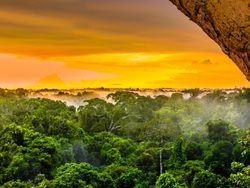
Tumucumaque Mountains
Quick Navigation
Tumucumaque National Park is located in the northwestern part of Brazil amongst the Amazon Rainforest near the borders of French Guiana and Suriname. The national park encompasses an area of 15,009 square miles (38,874 sq km) creating Brazil's largest national park.
As large as some countries, it is the world’s largest tropical forest national park combining with Guiana Amazonian National park in French Guiana to create a protected area of 22,780 square miles (59,000 sq km).
Although the combined national parks are smaller than the three sister national parks of Parima-Tapirapeco National Park, Serrania de la Neblina National Park, and Pico da Neblina National Park, the neighboring reserves and scientific stations of Tumucumaque Mountains National Park and Guiana Amazonian Park make this collective protected area the largest.
The Amazon Rainforest is globally renowned and the significance of the ecological importance of the rainforest to the global community is equally understood. This Guiana Shield between the Amazonian National Park and Tumucumaque Mountains National Park is one of the most important and largest ecological regions of protected tropical rainforest in the world.
The majority of the wildlife is indigenous and not found in any other region of the world. This Amazon Rainforest region is home to predators like the jaguar. There are multiple species of primates, mammals, birds, reptiles, and amphibians.
Highlights
Tumucumaque is one of the most diverse ecology settings in the world, and the abundance of that diversity is the highlight of the park.
Amazon Rainforest
 The Amazon Rainforest is one of the most well-known wilderness areas in the world. Of the 2,700,000 squares miles (7,000,000 sq km) of the Amazon River basin, 2,100,100 square miles (5,500,000 sq km) of it are blanketed with the Amazon Rainforest.
The Amazon Rainforest is one of the most well-known wilderness areas in the world. Of the 2,700,000 squares miles (7,000,000 sq km) of the Amazon River basin, 2,100,100 square miles (5,500,000 sq km) of it are blanketed with the Amazon Rainforest.
The Majority of the rainforest is found within the country of Brazil accounting for 60% of the entire Amazon Rainforest. Neighboring Peru accounts for the second-largest portion at 13%.
The Amazon Rainforest has the greatest biodiversity in the world with an estimated 16,000 different species of trees. The number of individual trees is estimated at just below 400 billion. The tens of thousands of other floral species create a thriving ecosystem for an abundance and diverse collection of wildlife.
It is estimated that the Amazon Rainforest has over 2,000 species of mammals and birds, 2,200 species of fish, and over 2.5 million species of insects. There are new species being discovered at any given moment, making this the most biologically rich and diverse ecosystem in the world. One in ten of all wildlife species are found in the Amazon Rainforest.
The rainforest falls between the Guiana Highlands, the Andes Mountains, the Brazilian central plateau, and the Atlantic Ocean. This is the largest rainforest in the world, and collectively across the nine countries that share portions of it, it is the largest protected ecosystem in the world both in size and number of species.
Tumucumaque Mountains Trails
Tumucumaque is one of the newest national parks. There are no established trails in the park and much of the efforts now are currently directed at research and assessing the best way to integrate enjoyment of the park while protecting the pristine wilderness that it protects.
Tumucumaque Mountains Highlights
- Largest tropical forest
- Ecological diversity
Park Map
Sources
- Britannica, Amazon Rainforest, https://www.britannica.com/place/Amazon-Rainforest, retrieved June 2020.
- Britannica, Tumucumaque National Park, https://www.britannica.com/place/Tumucumaque-National-Park, retrieved June 2020.
- LAC, Tumucumaque Mountains National Park, https://lacgeo.com/tumucumaque-mountains-national-park-brazil, retrieved September 2019.
- Lonely Planet, Tumucumaque National Park, https://www.lonelyplanet.com/brazil/amapa/attractions/tumucumaque-national-park/a/poi-sig/1591803/1315100, retrieved June 2020.
- New Scientist, World’s Largest Tropic Forest Park Created, https://www.newscientist.com/article/dn2712-worlds-largest-tropical-forest-park-created/, retrieved September 2019.
- Save the Amazon Rainforest, Unique Places of Interest, https://www.amazon-rainforest.org/places-of-interest/, retrieved September 2019.
- World Wildlife Fund, Brazil Creates The World’s Largest Tropical Forest Park, https://www.wwf.org.uk/updates/brazil-creates-worlds-largest-tropical-forest-park, retrieved September 2019.
- World Wildlife Fund, Amazon, https://www.worldwildlife.org/places/amazon, retrieved June 2020.
- World Wildlife Fund, Tumucumaque Mountains National Park, https://wwf.panda.org/knowledge_hub/where_we_work/amazon/species/tumucumaque_brazilian_national_park/, retrieved September 2019.








